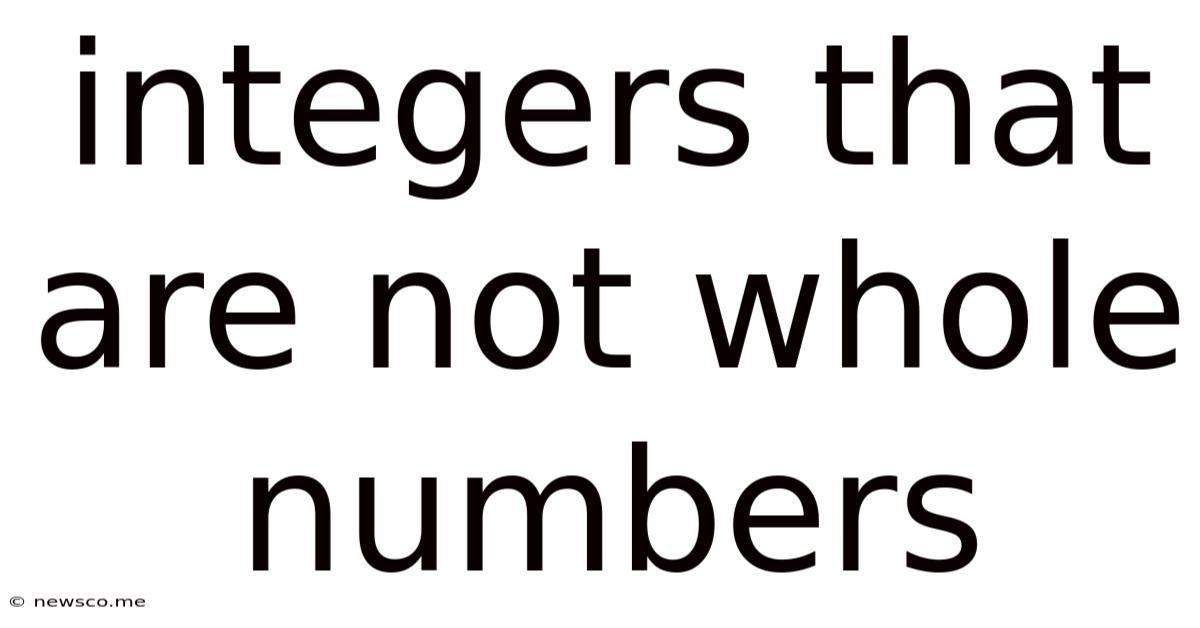Integers That Are Not Whole Numbers
News Co
Apr 12, 2025 · 5 min read

Table of Contents
Integers That Are Not Whole Numbers: A Deep Dive into Mathematical Concepts
The seemingly simple statement, "integers that are not whole numbers," might initially seem contradictory. After all, aren't all integers whole numbers? The answer, surprisingly, is no. This apparent paradox stems from a nuanced understanding of the different number sets within mathematics and how they relate to one another. This article will delve into the intricacies of number systems, clarifying the distinction between integers and whole numbers and exploring the implications of this difference.
Understanding Number Systems: A Foundation
Before we dissect the core question, let's establish a firm grasp of the fundamental number systems. This foundational understanding is crucial to appreciating the subtle yet significant difference between integers and whole numbers.
1. Natural Numbers (Counting Numbers):
These are the numbers we use for counting: 1, 2, 3, 4, and so on. They form the basis for all other number systems. Mathematically, they are represented as ℕ = {1, 2, 3, 4, ...}. Note that zero (0) is typically not included in the set of natural numbers.
2. Whole Numbers:
Whole numbers extend the natural numbers by including zero. They are represented as 𝕎 = {0, 1, 2, 3, 4, ...}. This seemingly small addition is significant in many mathematical contexts.
3. Integers:
Integers encompass whole numbers and their negative counterparts. They are represented as ℤ = {..., -3, -2, -1, 0, 1, 2, 3, ...}. This is where the core of our discussion lies. Integers include both positive and negative whole numbers, as well as zero.
4. Rational Numbers:
Rational numbers can be expressed as a fraction p/q, where p and q are integers, and q is not zero. This set includes all integers (since any integer can be expressed as a fraction with a denominator of 1), as well as fractions like 1/2, 3/4, -2/5, etc.
5. Real Numbers:
Real numbers encompass all rational numbers and irrational numbers (numbers that cannot be expressed as a fraction, such as π and √2). This is the broadest number system commonly used in everyday mathematics and beyond.
The Crucial Distinction: Integers vs. Whole Numbers
The key takeaway from the above is the inclusiveness of each number system. Whole numbers are a subset of integers; all whole numbers are integers, but not all integers are whole numbers. This is where the seeming contradiction arises. Integers that are not whole numbers are simply the negative integers.
Negative Integers: The Missing Piece
The negative integers (-1, -2, -3, and so on) are integers that are not whole numbers. This is because the definition of whole numbers explicitly excludes negative values. They represent quantities less than zero, commonly used in various applications like temperature, debt, and elevation below sea level.
Applications and Examples of Negative Integers
Negative integers are far from abstract mathematical concepts; they have tangible applications across numerous fields:
1. Finance:
- Debt: A debt of $50 is represented by -50. Negative numbers represent money owed.
- Bank balances: A negative bank balance indicates an overdraft.
- Financial statements: Negative figures in profit/loss statements represent losses.
2. Temperature:
- Celsius and Fahrenheit scales: Temperatures below zero are represented by negative numbers. -10°C indicates a temperature ten degrees below freezing.
3. Elevation:
- Geography: Elevations below sea level are represented using negative numbers. -100 meters indicates a location 100 meters below sea level.
4. Physics:
- Velocity and acceleration: Negative values represent movement in the opposite direction.
- Electric charge: Negative charge is represented by negative numbers.
5. Computer Science:
- Data representation: Negative numbers are fundamental in computer programming and data storage.
- Coordinate systems: Negative coordinates are used in various graphical representations.
Misconceptions and Common Errors
A common source of confusion stems from the imprecise use of language. People often use "integer" and "whole number" interchangeably, leading to misunderstandings. It's crucial to remember the formal mathematical definitions to avoid errors.
Avoiding Ambiguity
To avoid confusion, it's best to use precise terminology. Instead of saying "integers," specify "non-negative integers" if you mean whole numbers. This ensures clarity and prevents misinterpretations.
Beyond the Basics: Exploring Further Number Systems
While we've focused on integers and whole numbers, delving further into more complex number systems provides a richer understanding of the mathematical landscape:
Complex Numbers
Complex numbers extend the real numbers by incorporating the imaginary unit "i," where i² = -1. These numbers have a real part and an imaginary part, expressed in the form a + bi, where 'a' and 'b' are real numbers. Complex numbers are essential in many areas of mathematics, physics, and engineering.
Transfinite Numbers
These numbers are used to represent the sizes of infinite sets. Georg Cantor's work on set theory introduced concepts like aleph-null (ℵ₀), representing the cardinality of the set of natural numbers, and higher transfinite numbers.
Conclusion: The Significance of Precision in Mathematics
The seemingly simple distinction between integers and whole numbers underscores the importance of precise mathematical language and definitions. While the difference might appear minor at first glance, understanding the nuances of number systems is crucial for accurate mathematical reasoning, problem-solving, and avoiding ambiguity in various applications across different fields. The concept of integers that are not whole numbers—the negative integers—highlights the rich and diverse nature of the mathematical world, proving that even seemingly straightforward concepts can harbor unexpected depths. The careful and precise use of mathematical terminology is paramount for clear communication and accurate computations. This detailed exploration of number systems serves as a foundation for more advanced mathematical concepts and further studies.
Latest Posts
Related Post
Thank you for visiting our website which covers about Integers That Are Not Whole Numbers . We hope the information provided has been useful to you. Feel free to contact us if you have any questions or need further assistance. See you next time and don't miss to bookmark.